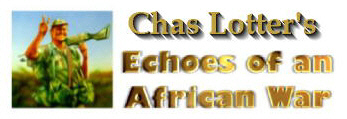

November Art Gallery ~ a selection from
The RLI and Selous Scouts Albums
by courtesy of Lt. Col. Ron Reid-Daly C.L.M., M.B.E.
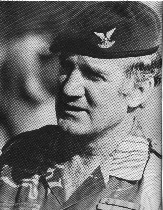
About Lt. Colonel Ron Reid-Daly
Lt. Col. Ron Reid-Daly, the custodian of the Rhodesian Light Infantry and Selous Scouts photograph albums, has made this art gallery selection possible. We are grateful to the Colonel for his enthusiastic endorsement of the Echoes of an African War project. Lt. Colonel Reid-Daly's career in the Rhodesian Army saw him serve in "C" Squadron, the Special Air Service, during the Malayan Emergency. Subsequently, he was the first Regimental Sergeant major (RSM) of the Rhodesian Light Infantry. He was commissioned whilst serving in the same unit. His leadership and crack soldiering skills stood him in good stead when he took command of the newly formed Selous Scouts. Under his leadership, the Selous Scouts became one of the recognised elite fighting forces in the Rhodesian Army. Lt. Colonel Reid-Daly lives in South Africa where his skills as an expert on counter insurgency and security matters continue to be in demand. Lt. Colonel Reid Daly's new, revised edition of the original best-selling Selous Scouts, Top Secret War, will shortly be published by Covos Books as Pamwe Chete-The Legend of The Selous Scouts
 This photograph taken from a Canberra bomber of the Rhodesian Air Force shows insurgents on parade. A detailed head count by intelligence officers figured that over 800 insurgents were on the parade ground - a figure later confirmed when the Selous Scouts attacked the Nyadzonya / Pungwe base belonging to ZANLA in August 1976.
This photograph taken from a Canberra bomber of the Rhodesian Air Force shows insurgents on parade. A detailed head count by intelligence officers figured that over 800 insurgents were on the parade ground - a figure later confirmed when the Selous Scouts attacked the Nyadzonya / Pungwe base belonging to ZANLA in August 1976.
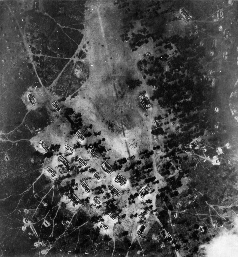 This aerial photograph was taken from a Canberra bomber of the Rhodesia Air Force. It shows the bodies of insurgents killed by Selous Scouts troops who infiltrated the Nyadzonya / Pungwe ZANLA base in Mozambique dressed as Frelimo troops. This is one of the few "external" raids conducted by elements of the Rhodesian army where near exact casualty figures are known. Documents captured at Mapai / Chimoio in a subsequent raid included the official ZANLA report of this raid. According to the ZANLA report, there were 1350 casualties in this raid, over half of these being killed in action.
This aerial photograph was taken from a Canberra bomber of the Rhodesia Air Force. It shows the bodies of insurgents killed by Selous Scouts troops who infiltrated the Nyadzonya / Pungwe ZANLA base in Mozambique dressed as Frelimo troops. This is one of the few "external" raids conducted by elements of the Rhodesian army where near exact casualty figures are known. Documents captured at Mapai / Chimoio in a subsequent raid included the official ZANLA report of this raid. According to the ZANLA report, there were 1350 casualties in this raid, over half of these being killed in action.
 This photograph shows the bridge over the Pungwe River that was demolished by Selous Scouts troops during the raid on the Nyadzonya / Pungwe ZANLA base. The bridge was downed to prevent Frelimo and ZANLA reinforcements arriving during the attack and also to disrupt vehicle traffic in the area - a common staging post for insurgent infiltrations into Rhodesia.
This photograph shows the bridge over the Pungwe River that was demolished by Selous Scouts troops during the raid on the Nyadzonya / Pungwe ZANLA base. The bridge was downed to prevent Frelimo and ZANLA reinforcements arriving during the attack and also to disrupt vehicle traffic in the area - a common staging post for insurgent infiltrations into Rhodesia.
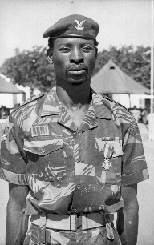
Sergeant Tamhla Palate of the Selous Scouts and holder of the Silver Cross of Rhodesia - the 2nd highest award for gallantry in action. For six months he acted as a pseudo insurgent and posing as a commander, led groups newly arrived into the country, into ambushes sprung by Rhodesian forces.
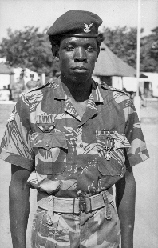 Sergeant Hungwe Rangariraye of the Selous Scouts, one of the most highly decorated soldiers in the Rhodesian forces, holder of both the Silver Cross of Rhodesia and the Bronze Cross of Rhodesia.
Sergeant Hungwe Rangariraye of the Selous Scouts, one of the most highly decorated soldiers in the Rhodesian forces, holder of both the Silver Cross of Rhodesia and the Bronze Cross of Rhodesia.

This insurgent was killed during Operation Miracle - a Rhodesian Army attack on a ZANLA base in Chimoio Circle, Mozambique, late 1979. He was caught by a Rhodesian artillery barrage- the effects of which are apparent on the surrounding vegetation.
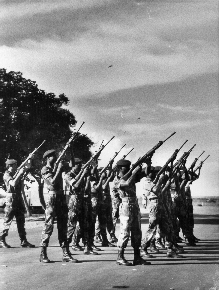 This photograph is of the honour guard at the military funeral for Captain Rob Warracker, Selous Scouts. Capt. Warracker was killed when the Rhodesian Air Force Canberra bomber he was in, was shot down by anti-aircraft artillery (AAA) as it overflew Malvernia - a small town on the Mozambique / Rhodesia border.
This photograph is of the honour guard at the military funeral for Captain Rob Warracker, Selous Scouts. Capt. Warracker was killed when the Rhodesian Air Force Canberra bomber he was in, was shot down by anti-aircraft artillery (AAA) as it overflew Malvernia - a small town on the Mozambique / Rhodesia border.
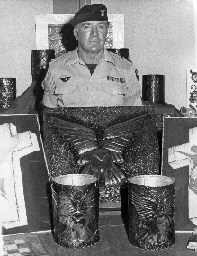
This photograph is of Lt. Colonel Ron Reid-Daly, surrounded by some of the Selous Scouts mementoes and trophies. The stylised swooping eagle, the identifying symbol of the Selous Scouts, is clearly evident on the beaten copper plaque that Colonel Reid-Daly is holding.
 WO 1 (RSM) M.S. Mavengere (left) and WO 1 (RSM) J.A. Pretorius, both of the Selous Scouts, holding a silver medallion that was presented to Lt. Col. Reid-Daly by the NCO's of the Selous Scouts when their commander retired from the Rhodesian Army.
WO 1 (RSM) M.S. Mavengere (left) and WO 1 (RSM) J.A. Pretorius, both of the Selous Scouts, holding a silver medallion that was presented to Lt. Col. Reid-Daly by the NCO's of the Selous Scouts when their commander retired from the Rhodesian Army.

Operation Miracle - the Rhodesian Army attack on the ZANLA base in Chimoio Circle, Mozambique. Gunners of the Rhodesian Army open fire on ZANLA positions with 25 pounder artillery pieces of World War II vintage. In this action, Rhodesian artillery accounted for a FRELIMO manned T54 tank that attempted to join in the battle against the attacking Selous Scouts.
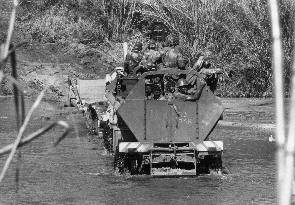
In this photograph taken at the commencement of Operation Miracle, the Rhodesian Army attack on the ZANLA base at Chimoio Circle, a bulldozer was used to tow the Selous Scouts column vehicles across the Gairesi River into Mozambique.
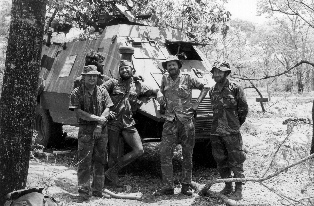
This photograph taken on Op. Miracle shows a Selous Scouts "Pig" - an armoured vehicle based on the ubiquitous Unimog chassis, and constructed by Selous Scouts mechanics from a "borrowed" West German design. Armed with a 20mm Hispano cannon taken from a retired Rhodesian Air Force Vampire aircraft, the "Pig" was a formidable vehicle.

Another view of the "Pig". The Selous Scouts made good use of vehicles in flying column attacks. The heavy armament carried on this vehicle is clearly evident. In addition to the 20mm Hispano cannon, the "Pig" carried two swivel - mounted Belgian MAG machine guns.
 The apparent informality of the Selous Scouts belied their effectiveness as a military unit. In the bush, there was no need of starched uniforms and parade ground appearances. The men are sitting on a captured ammunition box.
The apparent informality of the Selous Scouts belied their effectiveness as a military unit. In the bush, there was no need of starched uniforms and parade ground appearances. The men are sitting on a captured ammunition box.
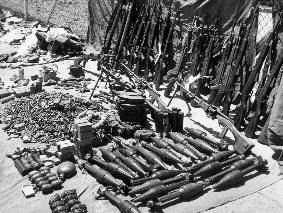
The Rhodesian Army captured vast quantities of weapons, ammunition and equipment from the insurgents. Whenever practical, captured equipment was carefully gathered up and sent back to the various unit barracks where the items would be checked over and added to the Rhodesian army's inventory. The weapons and equipment pictured here were gathered together after one particularly large contact, and include AK-47 and SKS assault rifles, RPD machine guns, RPG-7 rocket propelled grenade launchers, land mines, grenades, spare magazines, explosives, medical equipment and thousands of rounds of ammunition.
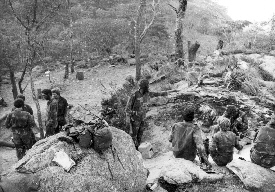
During Op. Miracle, the Rhodesian Army concentrated their attack on fortified ZANLA positions on a series of hill tops. The attackers met with stiff resistance and the hill-top trench complexes were only cleared after some heavy fighting and air strikes by Rhodesian Air Force Canberra bombers and Hawker Hunter fighter jets. In this photo, some Selous Scouts inspect the ZANLA positions they overran.
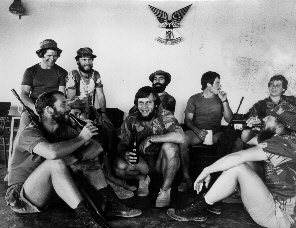
Selous Scouts troops enjoying a rare moment of relaxation in their pub at Inkomo Barracks, Salisbury.
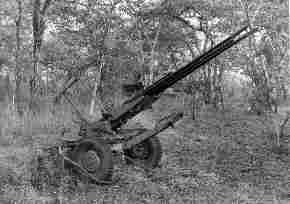
A Russian 23mm anti aircraft cannon captured by Selous Scouts troops during Operation Miracle. The Selous Scouts made much use of captured weapons during the war.
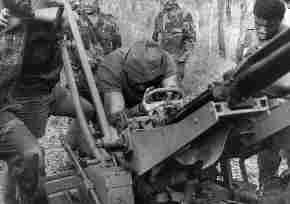
Another view of the captured Soviet 23mm anti-aircraft cannon.
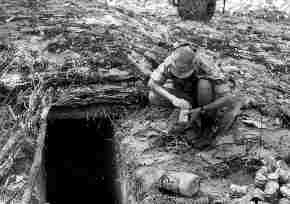 A Rhodesian soldier changing his portable radio's battery during an action against ZANLA base. These bases were well constructed with bunkers and trenches offering the defenders some protection against air assault. The bunker entrance is clearly visible. Clearing such fortifications was exceptionally dangerous work
A Rhodesian soldier changing his portable radio's battery during an action against ZANLA base. These bases were well constructed with bunkers and trenches offering the defenders some protection against air assault. The bunker entrance is clearly visible. Clearing such fortifications was exceptionally dangerous work

A Rhodesian Light Infantry soldier ready to deploy as a part of a fire force (a group of airborne troops inserted directly into a contact situation). The soldier's weapon is the belt-fed Belgian MAG. The helicopter is likely to be an Alouette III. The gunship's twin Browning machine guns can be seen to the left of the RLI trooper.
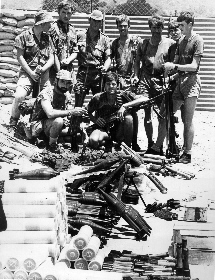 Rhodesian Light Infantry troops with some of the weapons and equipment captured after the "Battle of Hill 31" - this contact in the Honde Valley was, at the time (November 1976) the biggest single contact of the Rhodesian war. In this contact, the RLI accounted for 31 insurgents at the cost of one of their troops killed in action.
Rhodesian Light Infantry troops with some of the weapons and equipment captured after the "Battle of Hill 31" - this contact in the Honde Valley was, at the time (November 1976) the biggest single contact of the Rhodesian war. In this contact, the RLI accounted for 31 insurgents at the cost of one of their troops killed in action.
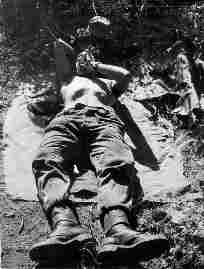
An RLI trooper relaxing between patrols in the Rhodesian bush.
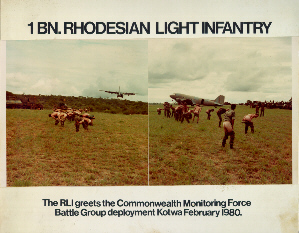 The Rhodesian Light Infantry greeting the arrival of Commonwealth Monitoring Forces at Kotwa in February 1980.CMF aircraft is a Hercules C130. Aircraft on the right is a Rhodesian Air Force Dakota (C47) configured as a paratroop transporter.
The Rhodesian Light Infantry greeting the arrival of Commonwealth Monitoring Forces at Kotwa in February 1980.CMF aircraft is a Hercules C130. Aircraft on the right is a Rhodesian Air Force Dakota (C47) configured as a paratroop transporter.